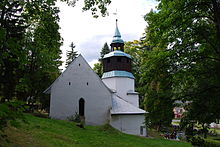Szklarska Poręba
Szklarska Poręba | |
|---|---|
 Town centre | |
|
UTC+2 (CEST) | |
| Website | Szklarskaporeba.pl |
Szklarska Poręba Polish: [ˈʂklarska pɔˈrɛmba] ⓘ (German: Schreiberhau) is a town in Karkonosze County, Lower Silesian Voivodeship, in south-western Poland. The town has a population of around 6,500. It is a popular ski resort.
An important regional and national centre for
History

The land on which the village was founded was bought in the 13th century from Duke
In 1578 several

Around 1900 several artists discovered the beauty of the countryside and formed the Schreiberhau artists' colony, among them Gerhart Hauptmann and his brother Carl, Otto Mueller, Wilhelm Bölsche, and composer Anna Teichmüller. In 1911, Wanda Bibrowicz founded the Silesian Artistic Weaving Workshop with an exhibition gallery, which existed until 1919.[4] Later, younger artists formed the St. Lukas artists' association. In 1925 the first winter games of the International Workers Olympiad (organised by the Socialist Workers' Sport International) were held in the town. Twelve national delegations participated.[5]
During World War II the Reich Labour Service (RAD) ran two Nazi German labor camps, RAD-Abteilung 6/103 and RAD-Abteilung 6/107, in the settlement.[6] In 1942, the Germans also established a forced labour camp for Soviet prisoners of war in its vicinity.[7]
After the defeat of
Transport

The town used to be connected via the Zackenbahn railway to Tanvald in Bohemia. The cross-border passenger line was closed in 1945 when the town was given to Poland and remained closed until 2010. In 2010 the cross-border railway connection was reconstructed and is now operated by passenger trains from Kořenov. The railway connection to Jelenia Góra plays a minor role, since the scale of the mining industry in the town's vicinity has decreased. Koleje Dolnośląskie D21 line runs from Szklarska Poręba Górna to Liberec.
A section of national road no. 3, also part of European route E65, passes through the town.
Sports
FIS Cross-Country World Cup events were held in Szklarska Poręba in 2012 and 2014. The Bieg Piastów cross-country skiing marathon is held in the town since 1976.
Notable people

- Joseph Partsch (1851–1925), German geographer
- Max Standfuss (1854–1917), Swiss scientist
- Wlastimil Hofman (1881–1970), Czech-Polish painter
- Mirosław Graf (born 1959), Polish former ski jumper and mayor of Szklarska Poręba
Twin towns – sister cities
Szklarska Poręba is twinned with:[9]
 Bad Harzburg, Germany
Bad Harzburg, Germany Harrachov, Czech Republic
Harrachov, Czech Republic Kazimierz Dolny, Poland
Kazimierz Dolny, Poland Kořenov, Czech Republic
Kořenov, Czech Republic Worpswede, Germany
Worpswede, Germany
Gallery
-
Mountain hut on Szrenica
-
"Jaskółka" Villa
-
Mineralogical Museum
-
Corpus Christi church
-
Observation tower on Wysoki Kamień
References
- ^ "Population. Size and structure and vital statistics in Poland by territorial division in 2019. As of 30th June". stat.gov.pl. Statistics Poland. 15 October 2019. Retrieved 14 February 2020.
- ^ a b c d Historia Miasta official website of Szklarska Poręba Archived 29 September 2008 at the Wayback Machine
- ^ Schüttig, p.88
- ^ "Wanda Bibrowicz". Słownik Biograficzny Ziemi Jeleniogórskiej (in Polish). Retrieved 8 March 2020.
- ^ Wheeler, Robert F.. Organized Sport and Organized Labour: The Workers' Sports Movement, in Journal of Contemporary History, Vol. 13, No. 2, Special Issue: Workers' Culture (Apr., 1978), pp. 191-210
- ^ "X Niederschlesien".
- ^ Zakład Narodowy im. Ossolińskich. p. 111.
- ISSN 0080-3480.
- ^ "Miasta partnerskie". szklarskaporeba.pl (in Polish). Szklarska Poręba. Retrieved 28 February 2020.
Bibliography
- Weczerka, Hugo (2003). Handbuch der historischen Stätten: Schlesien. Stuttgart: Alfred Kröner Verlag. ISBN 3-520-31602-1.
- Schüttig, Frank (2005). Das Riesengebirge entdecken. ISBN 3-89794-073-6.
External links
![]() Media related to Szklarska Poręba at Wikimedia Commons
Media related to Szklarska Poręba at Wikimedia Commons
- Skiing in Szklarska Poręba
- Municipal website
- [1]
- www.szklarska-poreba.pl Szklarska Poręba - gallery, news, map
- Szklarska Poreba Apartments






![Observation tower on Wysoki Kamień [pl]](http://upload.wikimedia.org/wikipedia/commons/thumb/4/4c/2018_Wie%C5%BCa_widokowa_na_Wysokim_Kamieniu_2.jpg/136px-2018_Wie%C5%BCa_widokowa_na_Wysokim_Kamieniu_2.jpg)
